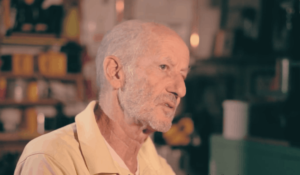Pondering Urban High School Improvement

“We want people to be perplexed—to embrace the paradox of starting new schools,” said Larry Rosenstock in the opening to the A+ Urban High School Summit in Denver Wednesday. As usually Larry has a rich list of quotes on the subject. Here’s my top ten from his opening remarks:
- When starting a school, ignore a few basic axioms. There are a lot of things you don’t need: bells, public address system, separate bathrooms.
- Keep it simple: complex structures drive complex behaviors.
- Make it about adult learning.
- People need to change conditions (Dewey); they should be in a constant state of reinventing things including themselves.
- We should ask students to use their head, use their hands, make things, and think about things.
- We should think more about production technology than consumption technology.
- Keep tinkering with your school, taking things apart and putting back together. Let people mix it up, keep it interesting.
- Balance stability versus churning–not unstable but not stuck.
- Let students do most of the talking and adults do most of the listening.
- Be about be revealing, about uncovering (not just covering content), ask students to do field work. Ask student to demonstrate their learning.
In addition to founding the famous High Tech High, Larry is a former lawyer, carpenter, and shop teacher. It’s also interesting to note (after last week’s events) that he was head master at Cambridge Rindge & Latin. He ran through a brief history of the public education and the American high school.
He reminded us (via Dewey) that the purpose of public education is not just to serve the public but to create the public. In that regard, Larry is a big proponent of socioeconomically integrated schools. High Tech High features a zip code lottery that ensures demographics that reflect the community.
In addition to class integration, Larry cares about pedagogy. He wants, “Yes, this could be you” moments, where student can picture themselves doing interesting and important work. (Deborah Meier says, “young people should have the opportunity to be around adults they can imagine themselves becoming.”)
His network of 12 schools propels students, about half in/near poverty, to and through college at an impressive rate—with about twice the average participating in STEM fields.
Larry doesn’t mind common expectations but he’s leery of standards that press for standardization. On the question of college for all, Larry notes that people never ask that question about their own kids. He railed on school boards, Carnegie units, school size, and more—he was irreverent, insightful, random, and poignant.
Denver Progress. Tom Boasberg noted the challenges of high school improvement and recapped the progress made in Denver under his watch as superintendent: graduation rates have improved by an impressive 20 points with threefold growth in student earning college credit and a 30% increase in college bound students.
The progress was spurred by the introduction of more than 25 new high schools—one third providing alternative pathways for struggling students. “In addition to welcoming new schools,” Boasberg said, “ we want to create a personalized and differentiated experience in our comprehensive high schools.”
John Berry, outgoing Aurora superintendent, noted their shift away from managed instruction to more autonomous schools. Berry said, “Choice is powerful, it equals ownership, and that equals motivation.”
Big Questions. In the last few panel discussions and breakout sessions, we discussed important and difficult questions including the following;
Is there really a difference between improvement and innovation?
- I make a clear distinction (in Wednesday’s EdWeek blog) that innovation is improving the system we have while innovation is creating the system we need. The blog discusses 10 possible dimensions of innovation—all worth a faculty and community conversation discussion.
- It’s important to try to introduce change in a school and system in the least disruptive way—that may involve a phase-out and phase-in strategy. Schools and districts also have to be thoughtful about their change capacity and balance execution (good teaching today) and innovation (better learning next year).
What about too much testing?
- With blended learning much of the assessment can move to the background and be imbedded into learning experiences. However, we need better competency-tracking systems to capture, synthesize, and report the flood of data.
- See Data Backpack: Portable Record & Learner Profiles for a full description. Utah recently implemented a portable record that will follow a student from school to school (SB82).
The state board is reconsidering graduation requirements in the next two weeks. What should they be requiring? (It’s worth noting that the question and audience response showed strikingly low regard for current and planned standardized assessments)
- Bill Kurtz, DSST, gave a great answer: it should be high enough to give all students viable education and career options. Right now, requirements are below what the military requires.
- States should phase in Common Core expectations over the next three years using a minimum cuts score on new PARCC tests starting 2016.
What should a school or district do now?
- Open a couple flex schools fast to create options and show the community how a competency-based environment works. (See 10 Reasons Every District Should Open a Flex Model.)
How do we make sure schools keep the kids they have and don’t dump problem kids on other schools?
- State policy that provides weighted, portable, and performance-based funding can partially address this problem (see Funding Students, Options & Performance.)
- Like NOLA, as Denver shifts to more of a portfolio of options, it will be important to have a community conversation about the desired level of coordination of transportation, enrollment, discipline, and facilities. (See yesterday’s blog summarizing a portfolio chat in NOLA).
How do we recruit more teachers of color?
- Bill Kurtz said, “It starts with graduating more low income students of color from high school and college.”
- We also have the opportunity to improve working conditions and career options (see infographic, paper on this topic out 5/7)—and that should improve recruiting.
Van Schoales and his team at A+ created a great conversation hosted in the spectacular new Colorado History museum.
For more see Smart Cities: Denver’s Advocates & Partnerships and Smart Cities: Early Observations (a summary of the portfolio strategy unfolding in Denver and other cities).





0 Comments
Leave a Comment
Your email address will not be published. All fields are required.